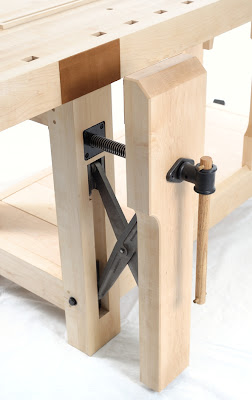This
week at Benchcrafted we're building a Split Top Roubo for a
long-overdue website update. We need to take some fresh pics of the STR
with our new handwheels, and the Crisscross. We're also taking the
opportunity to shoot some video of a few aspects of the build that we'd
thought potential builders would find useful.
First
up is a video on how we cut square bench dog holes. You might be
surprised how many folks think these are done with a chisel and mallet.
They are actually milled into the side of the dog hole board (strip),
capped with a thin piece, then glued to the rest of the top.
Getting
all that wood out of the way is not easy. Even for machines. Okay, a
dado head and a sliding table saw is simply the best way to do it, but
not everyone has access to a machine like that. The next best route,
ahem, is a router.
Here's how we get excellent results, without burning or blowout, efficiently and safely. (You might want to read
this post before you read this one further, we've been over some of this before.)
First
we lay out every dog hole and draw its extents clearly with a pencil.
Then we mark a big X where each hole goes. Once you get rolling and
moving the template around its very easy to mess up locations. The big X
really helps.
Then
we use a square and marking knife to scribe across the grain at each
hole, on the top edge and bottom edge of the dog strip. This helps
prevent blowout from the router, and makes a really clean, crisp
opening. Don't skip this step, although we say its sort-of optional in
that older post. Ignore that.
We
use two routers. The first one uses a template guide that keeps the bit
about 1/8" away from the template. This is a hogging cut, but requires
care to execute. It get lots of material out of the way so the second
router can work at ease and make a fine cut without a lot of load.
The
other line of defense in eliminating blowout is to use climb
cuts--that's when you move the router in the same direction the bit it
rotating. It's dangerous if you're unfamiliar with the technique, so
read up and practice if you're uneasy. Two of the four arrises in each
hole are favorable for anti-climb ("regular" against-the-rotation)
cutting, and two require climb cutting (anti-climb cutting would blowout
the unsupported grain). If this all sounds confusing, just keep this in
mind. When riding the template (with both router setups) you ALWAYS
take a cut by entering from the outside and moving INTO the hole. NEVER
route by entering from one end, then riding the template out the other
end--you'll blow out. Entering in an anti-climb cut, you'll need to move
away from the template about 2/3 of the way through the cut, exit, then
re-enter the same side--you'll now be climb cutting. DO NOT start
routing with a climb cut. By beginning each side anti-climb and routing
away almost all of the material, you leave little chance for the router
to "bite" when you re-enter for the climb cut, since there isn't much
material left to bite.

Here's the final line of defence against blowout. It's a cutter I call "super bit". A machinist friend
gave me this bit some time ago when it became too dull to do quality
milling in metal. Its a solid carbide, four flute, center cutting end
mill. And it is simply amazing. A couple months ago I took this bit to
Kelly Mehler's School of Woodworking to teach a class on building
workbenches. This bit saved the class. I bet we milled close to 100
mortises with it, in hard maple. I still have not sharpened the bit. I
just clean it. That's it. The cutter is 1/2" diameter and the smooth
shank is exactly the same diameter as the cutting diameter. So I use the
smooth portion of the shank as a bearing. It's the best pattern bit
I've ever used.
The
cutting geometry of the bit allows it to cut wood, especially hard,
dense, figured wood, with virtually no regard to grain direction. It
will cut end grain maple and leave a silky-smooth surface in its wake.
It is in a word, awesome. Make sure you click on the image below and
appreciate the quality of cut in this hard maple.
And finally, here is the video.
































